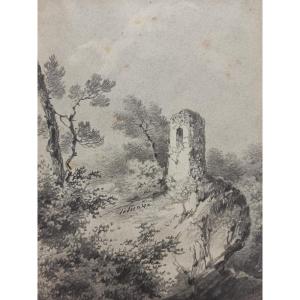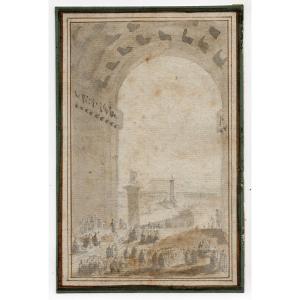Landscape in Provence with a promontory
Charcoal on paper
19.5 x 14.5 cm
Signed in the center of the composition “letuaire”
Framed, under glass
Dimensions with the frame: 29.5 x 24 cm
Good condition, slight foxing in the sky
***
Either a drawing made on the motif or a memory of a walk in the heart of the Provence countryside, this charcoal drawing by Pierre Letuaire is an elegant and poetic representation of what one might not pay attention to unless an artist did not know so well how to capture the passage of time on the stones and the permanence of the movement of nature around what man has built.
***
Pierre Letuaire's life and career are entirely linked to the city of Toulon, whose history, coastline and light were the primary sources of inspiration for his works throughout the century. The art of drawing also, in a way, never ceased to inspire him, in all the variety of its techniques and possibilities.
Pierre Letuaire taught drawing all his life, in schools and colleges, as well as in his private studio in Toulon, this port city both surrounded by rocky landscapes and open to the Orient, where the power of the paintings of the painters of history Pierre-Jacques Volaire (1729 – 1799) as well as Laurent Julien (1740 – 1820) – the only attested master of the artist – were to still impress many amateurs. Letuaire was himself the first teacher of painters who, unlike him, had the ambition of oil painting, the desire to exhibit at the Salons, to travel and to explore Africa by themselves. of the North and the wider horizons – all things that he certainly decided, at some point in his career, not to do. Among his pupils, let us particularly mention Vincent Courdouan (1810 – 1893), the painter and navigator Barthélémy Lauvergne (1805 – 1871) as well as the delicate Orientalist Emmanuel Lauret (1809 – 1882).
The Fondation Custodia in Paris, for example, has a fine set of studies that are both free and meticulous, rapid and poetic, which demonstrate both an economy of means and a profusion of ideas for compositions, pictorial effects and of graphic research, reminiscent, over the century, of studies of the sky by Paul Huet or even the small-format drawings and watercolors of Eugène Ciceri or Henri Harpignies. Part of this set was exhibited in the fall of 2022 in Paris, proof that Letuaire is a remarkable draftsman in his century who still deserves our attention.
***
When one studies Provençal painting, it is always a pleasure to be able to quote the fascinating art historian, Jean-Roger Soubiran, here over extracts from the catalog of the exhibition dedicated to Pierre Letuaire, at the Toulon museum between November 1985 and February 1986 :
The Provence of Letuaire is not a land of light or colors, but a country of cutouts and structures. His landscapes are vedute, topographical views that often make one think of drawings by engravers, chisel projects or etchings, as in the 17th century. The subject is subordinated to the description of nature, where the accuracy of the observation, the correctness of the narration reigns. However, the coldness and calm of the analysis are only apparent and veil a very real modesty and sensitivity. It breaks through in the rapid zig-zag writing, in the nervous stripes which suggest the shadows inside the foliage. Elsewhere, the sheets, far from being drawn one by one, as the neoclassical aesthetic would have it, are rendered globally by doodles, spontaneous corkscrews of total freedom that can go as far as the entanglements of an automatic writing where we will find the extravagant modernity of a (Félix) Ziem.
Letuaire's drawings mainly concern Toulon, its immediate countryside and its coastline, from Sainte-Marguerite to Saint-Mandrier. The Varois drawings were executed during the salutary stays accompanying his escape from cholera in 1835 (he took refuge in Lorgues and pushed to Gap) and 1849 (Le Luc) but also during his travels as a correspondent general of the magazine "L'Illustration".































 Le Magazine de PROANTIC
Le Magazine de PROANTIC TRÉSORS Magazine
TRÉSORS Magazine Rivista Artiquariato
Rivista Artiquariato